Description: This herbaceous perennial plant is about 1½–3' tall, branching occasionally. The stems are green, terete to angular, and either glabrous or sparsely hairy along two opposite lines. The opposite leaves are up to 5" long and 3" across; they are lanceolate to ovate in shape and smooth or slightly undulate along their margins. The upper leaf surface is yellowish green to dark green and glabrous (or nearly so), while the lower leaf surface is pale to medium green and glabrous to sparsely hairy along the undersides of the veins. The petioles are ¼–½" long. From the axils of the middle to upper leaves, there develops 1-3 flowers that are nearly sessile. Less often, such flowers will terminate a lateral stem that is up to 6" long, directly above a pair of leaves.
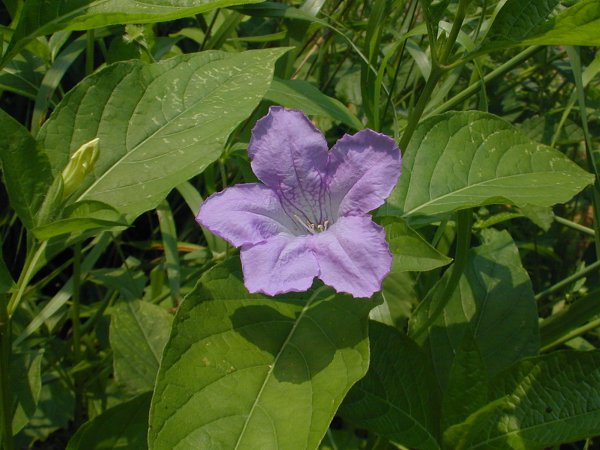
Each flower is about 2" long and 1½" across, consisting of a funnelform corolla that is pinkish lavender to bluish violet (rarely white, except at its base), a green short-tubular calyx with long slender teeth, 4 inserted stamens, and a pistil with an inserted style. The corolla is narrowly tubular at the base, but it spreads outward to form 5 rounded lobes. The lobes of the corolla have undulate edges and a delicate appearance. At the throat of the corolla, there are several fine veins that are purple and somewhat reticulated; they function as nectar guides for visiting insects. The tubular portion of the calyx is about ¼" long or a little less, while its teeth are ½–1" long, linear-lanceolate in shape, strongly ciliate along their margins, and 2-3 mm. across.
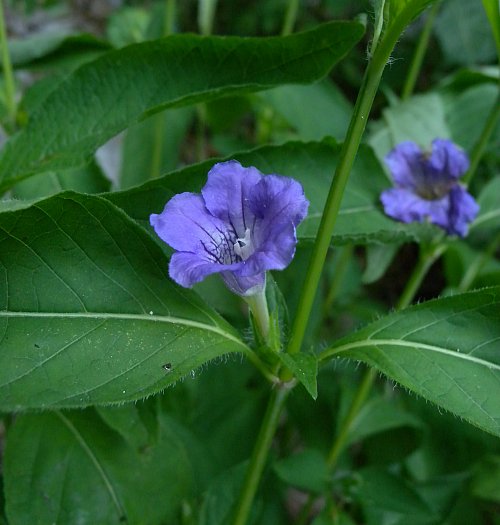
The blooming period occurs during the summer for 2-3 months. Each diurnal flower lasts only a single day; a single mature plant will have about 0-2 flowers in bloom during a typical summer day. The flowers are often partially hidden by the foliage. Afterwards, the flowers are replaced by glabrous seed capsules that are up to ¾" long. Each of these capsules contains several seeds that are released explosively. Individual seeds are about 3 mm. (1/8") across, flattened-globoid in shape, and brown to dark brown. There is a less common form of this plant that produces non-showy cleistogamous flowers (f. cleistantha); it usually has more narrow leaves than the typical form (f. strepens).
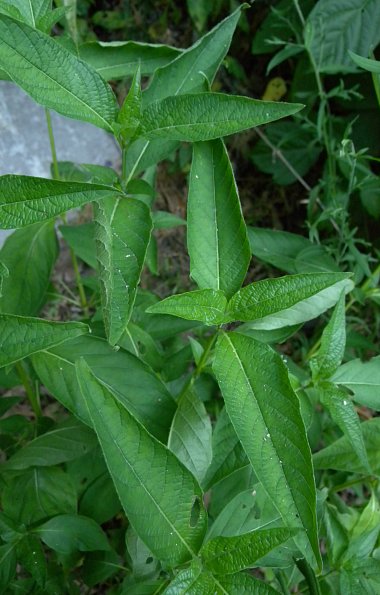
Cultivation:
The preference is light shade or partial sun, moist to mesic
conditions, and either loamy or rocky soil containing some organic
matter. This plant is not often bothered by either disease and insect
pests. It may fail to flower in areas with medium to dense shade.
Range & Habitat:
The native Smooth Wild Petunia occurs occasionally in southern and
central Illinois, while it is absent in the northern section of the
state (see Distribution
Map). Habitats include moist to mesic open
woodlands, woodland edges, areas along woodland paths,
thickets, thinly wooded slopes along rivers, and rocky banks
of streams. In woodlands where there is an absence of fire or other
disturbance, populations of this plant may decline because of
excessive shade, particularly when those woodlands have become
dominated by Sugar Maple (Acer
saccharum) and other woody vegetation that cast heavy
shade.
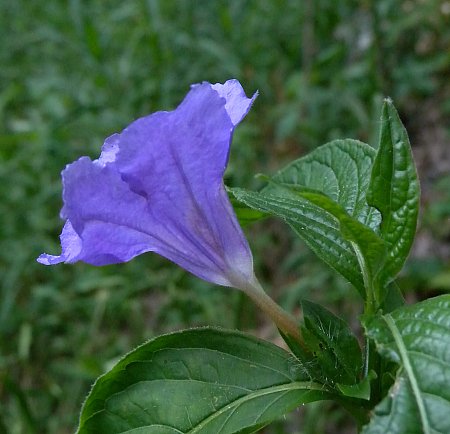
Faunal
Associations:
The flowers have few visitors, although their nectar and pollen
occasionally attract the smaller long-tongued bees (personal
observation). Robertson (1929) observed the long-horned bee, Synhalonia
speciosa, visiting the flowers of Smooth Wild Petunia.
According to MacRae (1991), the adults of some metallic wood-boring
beetles (Acmaeodera spp.)
also visit the flowers. Sometimes pieces of the corolla are used by
leaf-cutting bees (Megachile spp.) in the
construction of their brood
nests; these bees may also visit the flowers for nectar and pollen. The
caterpillars of a butterfly, Junonia coenia
(Buckeye), have been observed feeding on the foliage of Ruellia
spp. (Wild Petunias). Otherwise, little is known about
floral-faunal relationships for plants in this genus.
Photographic Location:
Along a path in a mesic area of Busey Woods, Urbana, Illinois, and
along the rocky bank of a stream in southern Illinois.
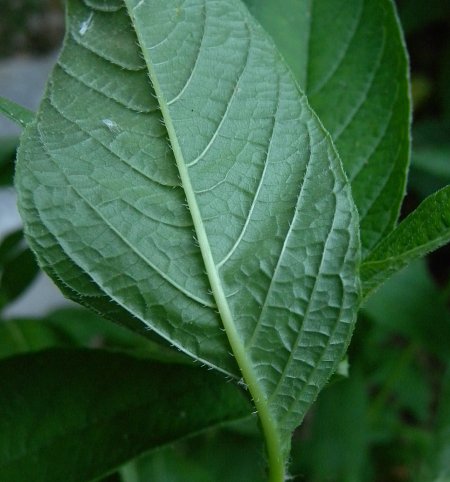
Comments: The flowers of Ruellia spp. (Wild Petunias) have a striking resemblance to the flowers of the cultivated Petunia (Petunia × hybrida), which has been introduced from South America and belongs to a different family of plants (Solanaceae). However, the flowers of Wild Petunias have less diversity of color. Mohlenbrock (2003) describes 4 Ruellia spp. in Illinois; some of these are restricted to the southern one-third of the state. Smooth Wild Petunia (Ruellia strepens) is very similar in appearance to Carolina Wild Petunia (Ruellia caroliniensis) and Stalked Wild Petunia (Ruellia pedunculata). Its calyx teeth are wider (2.0–3.0 mm. across), whereas the latter two species have linear calyx teeth that are only 1.0–1.5 mm. across. Stalked Wild Petunia also differs by producing terminal flowers on long lateral stems only, rather than non-terminal flowers from the axils of leaves, and its stems are more hairy. Some authors regard Smooth Wild Petunia and Carolina Wild Petunia as variants of the same species. The remaining species of this genus in Illinois, Hairy Wild Petunia Smooth (Ruellia humilis), is a shorter plant with much hairier stems and leaves than Smooth Wild Petunia. Hairy Wild Petunia also prefers habitats that are more sunny and dry, such as prairies.